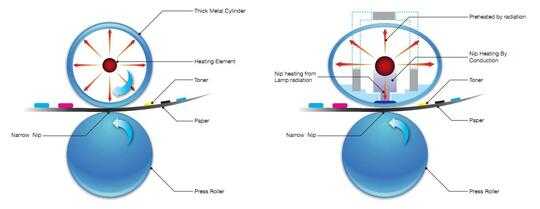The latest generation of laser printers warm up quickly because they use a new fuser technology, sometimes called "instant warm up". Instead of using a traditional metal roller, which takes a long time to heat, a thin membrane is used in conjunction with a heat lamp and a highly conductive metal heat transfer column. The difference is illustrated below:

On the left, the traditional method is shown. On the right is the new, flexible membrane approach. The thin membrane heats up almost immediately and special column transfers heat directly to the "nip".
A side benefit of the new approach is that the nip is wider, so the quality of the fusing is higher, as well.

7better heaters? – John Dvorak – 2018-02-12T14:13:17.317